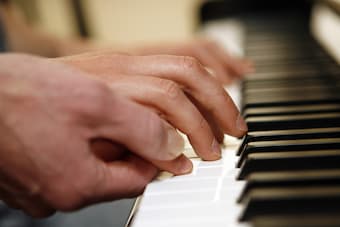
© Poise Alexander Technique Melbourne
At its roots, the Taubman Approach is based on the premise that there is a way to play the piano that is tension-free. However, in the past thirty years, I’ve discovered these life-changing techniques can benefit not only pianists and musicians of different disciplines, but also keyboard and smartphone users, and all other occupations that require extensive hand usage, from surgeons to cook to gardeners to factory workers. These same techniques can make hand activities tension and pain-free and prevent repetitive strain injuries such as carpal tunnel syndrome and dystonia.
The Basis of the Taubman Approach:
A common belief in the piano world is that fatigue, tension and pain are beneficial since they help develop muscles and endurance. However, pain is universally understood as an indication that something is wrong; fatigue, tension, and pain cannot be used as a tool for developing technique at the piano or indeed anywhere else when it comes to the use of our hands. Instead, fatigue, tension, and pain are the result of incorrect positions and movements.
In the musical world, we are often told that we are different from each other in many fundamental ways, and therefore there are as many approaches to playing the piano as there are pianists. However, whether we are musicians or simply music lovers, beneath the exterior of different colors, sizes, nationalities, and religions, The Taubman Approach is built on the truth that we all have the same bones, muscles, ligaments, nervous system, and brain structure unless there is some deformity. Since we are all built the same, when we move incorrectly at the piano or the computer keyboard we get many of the same or similar symptoms. With that in mind, just as incorrect positions and movements produce these symptoms, other positions and movements can prevent these symptoms and make playing, as well as a multitude of other activities that use our hands, easy.
These movements are for the most part hidden from the eye, which is why they have defied detection for a long time. The Taubman Approach has been successful in identifying the positions and movements that cause these symptoms. The Approach trains the pianist in the correct positions and movements that cure and prevent them and result in a healthy and natural technique. As mentioned above, these positions apply to non-musical activities as well, two of the most important being typing at the computer and the smartphone keyboards.

© TechnologyAdvice
Four Habits that Cause Tension and Fatigue for Both Musicians and Non-Musicians:
1. Curling: Curling the fingers produces tension because it activates a long flexor that extends from the fingertip to the elbow and pulls tightly over the wrist. Yet this problem exists with everyone. We are taught to always keep our fingers on the home row, when learning to type, and because the row is a straight line, and the fingers have different lengths, they are forced to curl in order to follow this instruction. So, people become habituated to this curled position from the beginning. The same thing happens with the thumb. When we are typing, either at the keyboard or on our smartphones we typically curl our thumbs. In both cases, the curled position means that typing is always done with tension, which leads to pain and injury.
The way to avoid curling with both fingers and thumb is to always keep them in their naturally curved position. Let your hand fall to your side, then bring it up in front of you, and notice that the fingers are in a natural position, neither curled nor straight. From this position, the fingers can move quickly, freely, and without tension. However, for the fingers to remain in this natural curved position, another part of the body has to participate. The part of the body that can move quickly to the left and right and up and down the keyboard and bring the fingers with it is the forearm. When they move together and the forearm brings the fingers to the key it has to press, the fingers can do their job while retaining their curved position and thereby avoiding tension.
2. Stretching: The initial instruction of keeping the fingers on the home row forces the fingers to stretch when they move to the right or left and to straighten when they have to reach the letters or numbers on the upper rows. Also, the thumb tends to move on its own, stretching in all directions as it types up and down the keyboard and hits the space bar, adding tension and causing pain. On the smartphone, the thumb stretches as it moves from the top to the bottom of the phone. Just as with curling, in order to avoid this stretching and keep the fingers and thumb close to each other, the forearm needs to move together with them.
3. Twisting: Moving the hand to the left and to the right from the wrist joint is an isolated and twisting motion that is not only uncomfortable but also a major cause of wrist pain as well as the swelling that is called ganglia. People tend to move the hand by itself from the wrist joint to reach the keys on the upper and lower right and left of the keyboard, which is twisting. Forearm motion eliminates this problem; initiating movement from the elbow instead of the wrist, the forearm moves together with the hand to bring the finger to the key.
4. Finger Isolation: Finger isolation occurs when all the fingers are down and one finger at a time lift by itself and then presses down on a key by itself. This kind of isolated motion causes tension in the fingers, hand, and the top and bottom of the forearm. The solution again is to move as a unit.
As mentioned above, curling, stretching, and isolating limb parts produce fatigue, tension, and pain. The opposite of this isolation is alignment. Martial arts and other Western whole-body disciplines emphasize alignment and coordination as prerequisites for correct and efficient movement. However, for a long time, proper alignment and coordination has not been properly understood and appreciated at the keyboard, since keyboard use requires small motions using small muscles. Because these motions are invisible, we can see the result but not what causes it. In fact, the better the technique, the less motion we see. The miracle of the Taubman Approach is that it understands the cause of these keyboard problems and offers solutions to them that can help everyone.
For more of the best in classical music, sign up to our E-Newsletter
Preventing Tension With the Taubman Approach
Edna Golandsky is a world-renowned piano pedagogue, the leading exponent of the Taubman Approach, and is the Founder of the Golandsky Institute. A graduate of the Juilliard School, where she studied under Jane Carlson, Rosina Lhévinne, and Adele Marcus, Ms. Golandsky has earned worldwide acclaim for her pedagogical expertise, extraordinary ability to solve technical problems, and her penetrating musical insight.
Website: www.ednagolandsky.com
Instagram: www.instagram.com/ednagolandsky
Facebook: www.facebook.com/egolandsky




